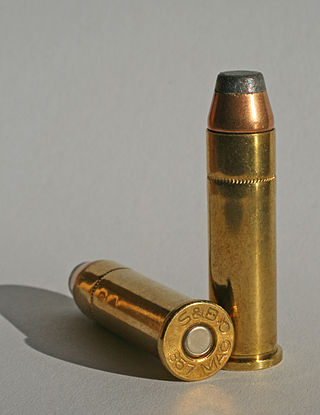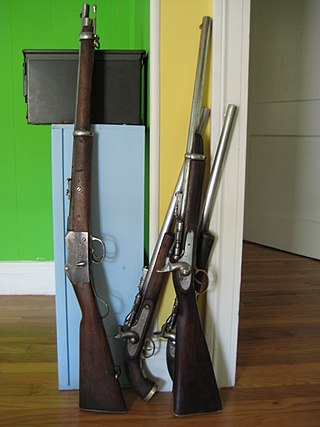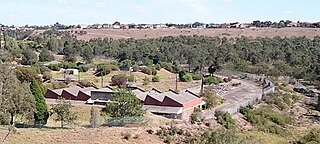
The Small Arms Ammunition Factories (SAAF) were ammunition manufacturing plants run by the Australian government. Nearly all of their production was for domestic use by their military, the police forces, and government-appointed agents.

The Small Arms Ammunition Factories (SAAF) were ammunition manufacturing plants run by the Australian government. Nearly all of their production was for domestic use by their military, the police forces, and government-appointed agents.
In 1888 the Colonial Ammunition Company of New Zealand founded an ammunition factory in Footscray, a suburb of Melbourne, Victoria. During World War One from 1915 to 1918 the plant made over 2 million rounds of rifle ammunition a year. It was purchased by the Australian government in 1927. [1]
The Defence Explosive Factory Maribyrnong opened in 1908. A factory annexe was built in 1912 to supply Footscray with domestically-produced cordite. It also had an ordnance annexe that produced artillery pieces, mortars, and shells. During World War One, the phrase "Made in Maribyrnong" referred to how central the town and its industries were to the Australian war effort.
The Footscray plant's headstamp was originally CAC from 1888 to 1918 and ->CAC<- (the letters between two horizontal "Government Property" arrowheads) from 1918 to 1920. The headstamp was changed to ->SAAF<- (for "Small Arms Ammunition Factory") from 1921 to 1923 and one lot in March 1924, A↑F ("AF" for "Ammunition Factory", the letters flanking a vertical arrowhead) during 1924 to 1925, "↑F" (vertical arrowhead to the left of the F) from 1925 to 1926, and MF (for "Military Factory") from 1926 to 1945. [2]
In August 1939, a plan was created to expand native ordnance production in case a war cut Australia off from the rest of the Commonwealth. The antiquated ammunition plant at Footscray was to be abandoned as soon as a more modern and efficient factory was built nearby. To differentiate between them, in 1940 the old factory briefly received the designation of Munitions Factory No.1 (MF1) and the new factory was designated Munitions Factory No.2 (MF2). Demand forced the old factory (later redesignated SAAF No.1) to remain open until the war's end. The new factory (now designated SAAF No. 2) would be the only one to remain open after the war. The plans to make one factory at Hendon northwest of Adelaide was expanded to two factories (designated SAAFs No. 3 & No. 4) that were built only a few hundred metres apart. Conversely, the original plans to make two small factories at Rocklea south of Brisbane (originally designated SAAFs No. 5 & No. 6) was abandoned and one large facility was made instead (SAAF No. 5). The sixth and last factory at Welshpool in Perth (originally to be designated SAAF No. 7) received the designation of SAAF No. 6.
In 1940 the workforce at Footscray grew from a few hundred men to 6,000 men and women at its peak. Employees worked 12-hour shifts for six days a week. A women's hostel was opened across the street to house the female workforce and ensure continuous operation of the production lines. The Maribyrnong complex employed 20,000 men and women at its peak, with women making up 52% of the workforce.
Headstamp is the facility's code letters at 10 o'clock, the two-digit year of production at 2 o'clock, and the type and mark of cartridge at 6 o'clock.
The small arms ammunition factories were fed by specialised facilities designed to supply their components.
In 1945, the facilities at Hendon (MH & MJ), Rocklea (MQ), and Welshpool (MW) were closed, followed by the original old Footscray ammunition factory (MF). The second Footscray facility (MG) was later redesignated to MF in 1949.
In 1986 Albion Explosives Factory was closed due to suburban encroachment. Production was moved to Mulwala Explosives Factory (MEF), New South Wales in 1988. Mulwala Explosives Factory was privatised in 2011 and then bought out by Thales Australia Ltd.
In 1989 the Australian government nationalised munitions manufacture under a government-owned company called Australian Defence Industries (Ltd.). [11] Its first round of business was to consolidate and regulate ordnance production. [11] The Explosives Factory Maribyrnong complex was closed during restructuring later that year.
Production at Ammunition Factory Footscray (AFF) was slowly wound down beginning in 1991 until it was closed in 1994. [12] A new factory run by Australian Defence Industries was opened elsewhere at Benalla, Victoria. When ADI was bought out by Thales in 2006, ADI was renamed Thales Australia Ltd. In 2012 Thales Australia spun off its factories at Benalla and Mulwala to form the Australian Munitions group. It is also responsible for managing any Australian military logistical functions involving munitions. [13]
Benalla still uses the ADI headstamp from 1994 to as recently as 2014. Production of 5.56mm NATO F1 Ball resumed in 1995 and F1A1 Ball began in c.2010. Both cartridges are similar, but the F1A1 ammo has a green meplat tip and the headstamp has dimples at the 3 and 9 o'clock position (a peculiarity of the electric bunter used by the new cartridge-making machinery). 5.56mm NATO F3 Blank production began in 1998 and is produced in batches every three years. Production of .50 BMG M33 Ball began in 1999 and 7.62mm NATO F4 Ball began in 2008. Since they now only produce Ball ammunition, headstamps since 1995 only include the contractor code at 12 o'clock and the two-digit production year at 6 o'clock. It also produces 20mm autocannon rounds and will possibly begin production of 81mm mortar shells as part of a 5-year reorganization plan. [14]
Since 2014 Australian Munitions produces civilian market ammunition under the Australian Outback brand. Civilian ammunition is in .223 Remington, .243 Winchester, .300 Blackout, and .308 Winchester and military surplus is in 5.56mm NATO F1A1 Ball and 7.62mm NATO F4 Ball. The civilian cartridges use Sierra- and Swift-brand match and hunting bullets with a special high-temperature-tolerant propellant.

Cordite is a family of smokeless propellants developed and produced in Britain since 1889 to replace black powder as a military firearm propellant. Like modern gunpowder, cordite is classified as a low explosive because of its slow burning rates and consequently low brisance. These produce a subsonic deflagration wave rather than the supersonic detonation wave produced by brisants, or high explosives. The hot gases produced by burning gunpowder or cordite generate sufficient pressure to propel a bullet or shell to its target, but not so quickly as to routinely destroy the barrel of the gun.

The Lee–Enfield is a bolt-action, magazine-fed repeating rifle that served as the main firearm of the military forces of the British Empire and Commonwealth during the first half of the 20th century, and was the standard service rifle of the British Armed Forces from its official adoption in 1895 until 1957.

A shell, in a military context, is a projectile whose payload contains an explosive, incendiary, or other chemical filling. Originally it was called a bombshell, but "shell" has come to be unambiguous in a military context. A shell can hold a tracer.

A center-fire is a type of metallic cartridge used in firearms, where the primer is located at the center of the base of its casing. Unlike rimfire cartridges, the centerfire primer is typically a separate component seated into a recessed cavity in the case head and is replaceable by reloading the cartridge.
The .30-06 Springfield cartridge, 7.62×63mm in metric notation, and called the .30 Gov't '06 by Winchester, was introduced to the United States Army in 1906 and later standardized; it remained in military use until the late 1970s. In the cartridge's name, ".30" refers to the nominal caliber of the bullet in inches; "06" refers to the year the cartridge was adopted, 1906. It replaced the .30-03 Springfield, 6mm Lee Navy, and .30-40 Krag cartridges. The .30-06 remained the U.S. Army's primary rifle and machine gun cartridge for nearly 50 years before being replaced by the 7.62×51mm NATO and 5.56×45mm NATO, both of which remain in current U.S. and NATO service. The cartridge remains a very popular sporting round, with ammunition produced by all major manufacturers.

The .303 British or 7.7×56mmR, is a .303-inch (7.7 mm) calibre rimmed tapered rifle cartridge. The .303 inch bore diameter is measured between rifling lands as is the common practice in Europe which follows the traditional black powder convention.

Deutsche Waffen- und Munitionsfabriken Aktiengesellschaft, known as DWM, was an arms company in Imperial Germany created in 1896 when Ludwig Loewe & Company united its weapons and ammunition production facilities within one company. In 1896 Loewe founded Deutsche Waffen- und Munitionsfabriken with a munitions plant in Karlsruhe (Baden), formerly Deutsche Metallpatronenfabrik Lorenz, and the weapons plant in Berlin. Shares that Loewe had in other gun- and ammunition plants were transferred to DWM. This included Waffenfabrik Mauser, Fabrique Nationale d'Armes de Guerre (FN) in Belgium and Waffen- und Munitionsfabrik A.G. in Budapest. The DWM was orchestrated by Isidor Loewe (1848–1910), as his brother Ludwig had died in 1886. Karl Maybach was employed by the Loewe company in 1901.

A headstamp is the markings on the bottom of a cartridge case designed for a firearm. It usually tells who manufactured the case. If it is a civilian case it often also tells the caliber: if it is military, the year of manufacture is often added.
A filling factory was a manufacturing plant that specialised in filling various munitions, such as bombs, shells, cartridges, pyrotechnics, and screening smokes. In the United Kingdom, during both world wars of the 20th century, the majority of the employees were women.

Kynoch was a manufacturer of ammunition that was later incorporated into ICI, but remained as a brand name for sporting cartridges.

The Government Arsenal (GA) is an agency of the Philippine government under the Department of National Defense, responsible for the production of basic weaponry and ammunition for the Armed Forces of the Philippines (AFP) and the Philippine National Police (PNP).

The Western Cartridge Company was an American manufacturer of small arms and ammunition formerly based in East Alton, Illinois. Founded in 1898, it was the forerunner of the Olin Corporation, formed in 1944, of which Western was absorbed into. Prior to that, Western acquired the Winchester Repeating Arms Company after Winchester went into receivership in 1931. The two would merge in 1935 to form Winchester-Western.

A Khyber Pass copy is a firearm manufactured by cottage gunsmiths in the Khyber Pass region in Pakistan.
The former Royal Ordnance Factory (ROF), Radway Green manufactures small arms ammunition for the British armed forces. It is located in the hamlet of Radway Green near Barthomley near Alsager in Cheshire in the UK.

The Colonial Ammunition Company (CAC) was an ammunition manufacturer in Auckland, New Zealand. Its predecessor, Whitney & Sons, was established by John Whitney with government encouragement in 1885 during the Russian Scare. Whitney later recruited investors to expand his factory in 1888. The other shareholders were Messrs Greenwood and Batley, of Leeds ; T. Hall, Esq., of Mount Morgan; J. D' Arcey, Esq.; Captain de Lusada, R.N.; J. Clarke, Esq.; and T.Y. Cartwright of Notts. They formed the Colonial Ammunition Company, the first ordnance manufacturer in Australasia.
Lithgow Arms is an Australian small arms manufacturer located in the town of Lithgow, New South Wales. Established by the Australian Government in 1912 as the Lithgow Small Arms Factory to ease reliance on the British for the supply of defence materials, it is currently owed by Thales Australia.

Ammunition is the material fired, scattered, dropped, or detonated from any weapon or weapon system. Ammunition is both expendable weapons and the component parts of other weapons that create the effect on a target.

Bangladesh Ordnance Factories (BOF) is the largest industrial supplier of the Bangladesh Army. Situated in Gazipur, it produces arms, ammunition, and equipment for the Bangladesh Armed Forces.

Defence Explosive Factory Maribyrnong is a heritage-listed military installation and former munitions factory at Cordite Avenue, Maribyrnong, Victoria, Australia. It was added to the Australian Commonwealth Heritage List on 22 June 2004.